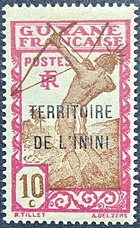Territory Of Inini
History
The purpose of the colony was to develop the interior separately from the coastal area around Cayenne. The colony came into effect on 6 June 1930, and was mainly a military affair. The territory was ruled by decree first by the governor of French Guiana and later by the prefect. Initially only three services were offered: water management, forest management, and mines.

In 1930, a total of seven military officers and nine gendarmes were stationed in the territory. The main focus was on the legal gold mining companies, and the difficult access to the mines in the jungle. In 1931, a labour force consisting of 535 Annamite prisoners who had revolted against French rule in Indochina were brought in to make the territory accessible. Senegalese Tirailleurs were used to guard and oversee the prisoners. In 1936, the governor informed Paris that the project was successful, because the interior could soon be opened for colonisation. In 1937, the prisoners at Camp Crique Anguille revolted.
In 1941, American troops were stationed in Suriname to protect the colony and its bauxite industry, which was primarily American-owned. One year later, Brazil declared war on Germany. Inini was part of Vichy France, a neutral state associated with Nazi Germany through the Armistice of 22 June 1940, and now found itself squeezed between two hostile countries, therefore the main effort of the administration was guarding the borders until 16 March 1943 when Inini sided with Free France. On 6 December 1944, the prisoner camps were abandoned and the Annamites returned to the normal prisons. The first group was released in July 1946, however the last group had to wait until August 1953.
The plan to develop the territory did not work out, owing to the difficulties of railroad construction in the interior. The ruins of the three prisons used may still be seen. In 1944, the Brazzaville Conference was held among Free French leaders which promised all citizens of France's colonies equal rights with French citizens after the war. Therefore, on 19 March 1946 all of French Guiana became a department of France; however, Inini would be administrated separately, because it was lacking basic services like health care and education. On 17 March 1969, the territory was dissolved into communes, and subject to regular democratic government.
Postage stamps

During this period, the postage stamps of French Guiana were overprinted with several variations on "TERRITOIRE DE L'ININI" and the omnibus issues for the Colonial Arts Exhibition in 1937 and the New York World's Fair in 1939 included stamps inscribed "ININI". Despite the limited audience, the stamps of Inini are commonly available at minimal prices today.
See also
References
- ^ "Vous qui voulez venir en Guyane". University of Florida (in French). 1953. pp. 28–29. Retrieved 3 August 2020.
1946 census data. On page 29, it was noted that there were an estimated 4,000 foreigners in the country who mainly worked in the interior, i.e. the illegal gold prospectors were not included in the statistics
- ^ "Création de territoire en Guyane française". Journal officiel de la Guyane française via Bibliothèque Nationale de France (in French). 6 June 1930. Retrieved 6 June 2020.
- ^ "Loi n° 46-451 du 19 mars 1946 tendant au classement comme départements français de la Guadeloupe, de la Martinique, de la Réunion et de la Guyane française". Government of the French Republic (in French). 19 March 1946. Retrieved 6 June 2020.
- ^ Thabouillot, Gérard (24 August 2023). Le territoire de l'Inini : 1930-1969 (in French). Ibis rouge éditions. ISBN 9782375205051. Retrieved 6 June 2020.
{{cite book}}:|website=ignored (help) - ^ "South America 1930: Vargas Revolution". Omni Atlas. Retrieved 4 June 2020.
- ^ "Au temps de l'Inini". Un Témoin en Guyane (in French). Retrieved 3 August 2020.
- ^ Thabouillot 2011, p. 43.
- ^ "Colloque : le territoire de l'Inini (1930-1969)". Blada. Retrieved 3 August 2020.
- ^ Thabouillot 2011, p. 44.
- ^ Thabouillot 2011, p. 48.
- ^ "Industrial Railways in French Guiana, 2014". International Steam. Retrieved 4 June 2020.
- ^ Donet-Vincent 2001, p. 215.
- ^ Donet-Vincent 2001, p. 217.
- ^ Donet-Vincent 2001, p. 218.
- ^ "Wereldoorlog in de West - Suriname, de Nederlandse Antillen en Aruba 1940-1945". Verzetsmuseum (in Dutch). Archived from the original on 9 August 2020. Retrieved 3 August 2020.
- ^ "1942: Brazil Declares War on Hitler's Germany". History.info. 21 August 2019. Retrieved 3 August 2020.
- ^ Donet-Vincent 2001, p. 220.
- ^ Donet-Vincent, Danielle (1 January 2006). "Les "bagnes" des Indochinois en Guyane (1931-1963)". Criminocorpus, Revue Hypermédia (in French). doi:10.4000/criminocorpus.182. S2CID 247825093. Retrieved 6 June 2020.
- ^ "Les chemins politiques, de Brazzaville à la Communauté (1944-1958)". Institut national de l'audiovisuel (in French). Retrieved 5 August 2020.
- ^ "Le territoire de l'Inini". France Philatelie (in French). 8 September 2016. Retrieved 6 June 2020.
Bibliography
- Donet-Vincent, Danielle (2001). "Les "bagnes" des Indochinois en Guyane (1931-1963)". Persée. Outre-Mers. Revue d'histoire (in French).
- Thabouillot, Gérard (2011). "Être chef de poste en Inini (1930-1969)". Persée. Outre-Mers. Revue d'histoire (in French). ISSN 2275-4954.